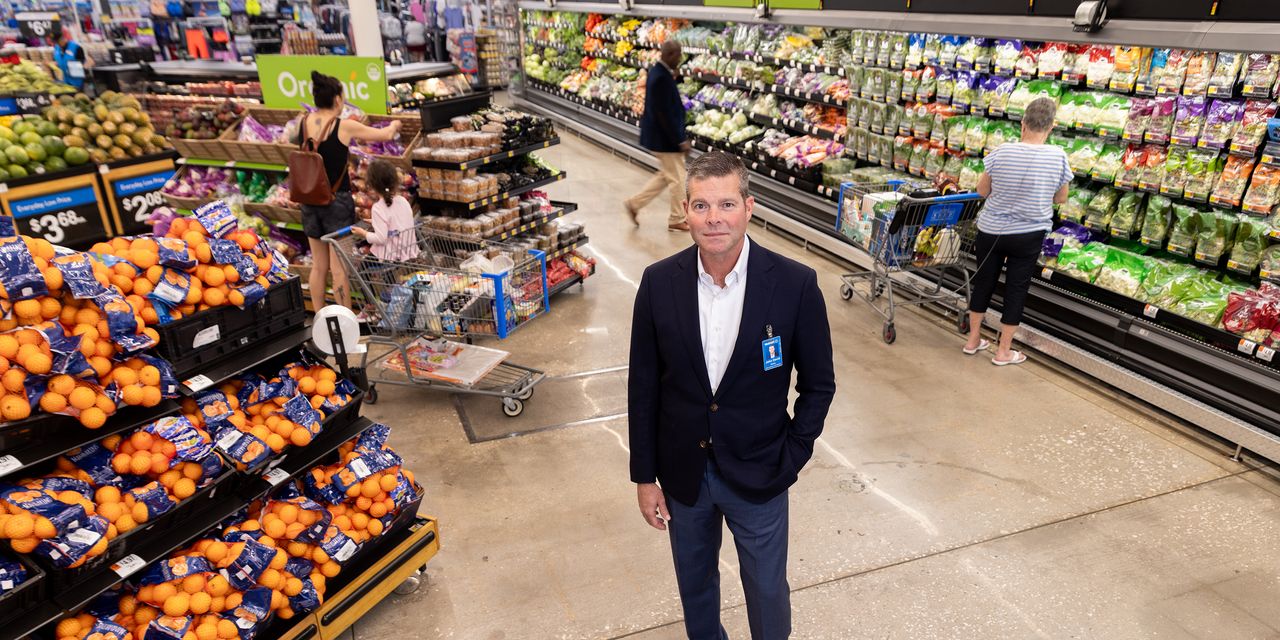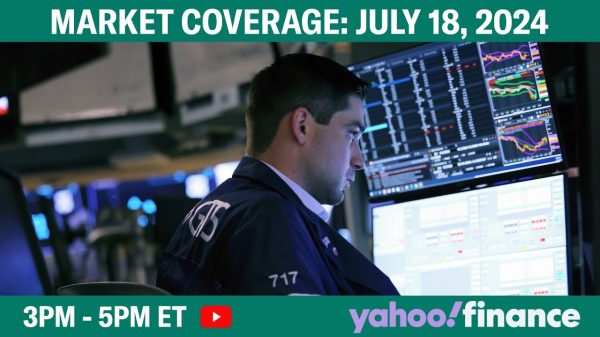John David Rainey stands on the cavernous floor of a Bentonville, Ark.,
Walmart
fulfillment center, joking and smiling with employees. They pass in a near-constant flow, keeping pace with online orders being processed by an army of robots.
That bustle reflects the handiwork of the chief financial officer: Rainey never takes his eye off the fusion of technology and talent that’s creating what he calls a “generational opportunity” to cement Walmart’s (ticker: WMT) dominance, while also increasing its profitability.
Just over a year after stepping into his new job at the world’s largest retailer, Rainey spoke with Barron’s for his first media interview.
Swapping his previous role as CFO at
PayPal
Holdings (PYPL), which boomed during the pandemic years, for one with a company with a more staid reputation wasn’t an obvious choice. But for Rainey, the chance to put his consumer expertise to work at Walmart’s mammoth scale was tempting. “When an iconic American company calls you, it’s a little bit of an intelligence test as to whether or not you return the call,” Rainey quips of his decision to take on the role.
Yet Rainey—whose job includes everything from tangling with Wall Street analysts to connecting with workers at a company bodega in Mexico City—admits he wasn’t fully sold on the job until he saw how fast and how successfully Walmart was moving. “It’s simply something I wanted to be a part of.”
Walmart certainly had good reason to bring Rainey aboard. His career has centered on using digital tools to facilitate seamless sales, and his previous tenures at PayPal and
United Airlines Holdings
(UAL) largely coincided with those stocks moving higher.
Rainey spoke with Barron’s on June 22 about how Walmart plans to beat
Amazon.com
(AMZN), keep higher-income shoppers, and harness tech to create new opportunities. The following is an edited version of that conversation.
Barron’s: You came to Walmart from PayPal at a time when tech is impacting every area of retail. How has that shaped your role as CFO?
Rainey: PayPal is a digital-first company, and the insights we had into our customers were significant. We had a good understanding of how customers transacted and what created more value for them and us. At Walmart, historically a lot of our customers transacted with us anonymously. Now we understand the footprint they leave behind when they shop. We can leverage that information to serve them better. When [we know] customers come to us and buy dog food on the third week of every month, we can tailor offerings to better serve them. We use artificial intelligence in automated storage and retrieval in our fulfillment centers [to help] robots better utilize the space. When one runs into another, or has to take a more circuitous route, we use AI to optimize that, so the robots can be more efficient in the future.
What surprised you most when you arrived at Walmart?
Our level of sophistication and supply-chain automation. I think some people have a perception that Walmart is a low-margin, tired old business, but it’s far from it. Our supply-chain automation is as advanced as what anyone is doing. It’s not just the robotics themselves, it’s also the software that goes with it. Combined, that helps us understand where to have our supply among our almost 5,000 stores in the U.S. The single-largest employee group we have at our corporate headquarters is technology employees.
We can’t talk about tech and not mention the threat of Amazon.
The team here does retail as well as anyone does in the world. We’re following the consumer in becoming an omnichannel retailer, which combines a great customer experience with a physical footprint. I would argue that the more difficult of the two is the latter. That physical footprint gives us an opportunity to play in the space, and do it with much more attractive economics. We’re not just playing in the space; we’re helping to define it.
In what way has having physical stores helped?
A lot of companies that were e-commerce-based or more digital saw significant benefits during the pandemic. Most of them have seen those benefits revert back to the trend line postpandemic. Not Walmart. The number of weekly active customers who engage with Walmart digitally has increased eleven-fold since before the pandemic. This underscores that we’ve always been a company known for value, and now we’re also being known for convenience.
Physical stores also come with shoplifting issues. How is “shrink” impacting Walmart?
This isn’t across the board in every one of our stores, but it’s acute in certain areas of the country where you see the standards for prosecution of this type of crime being relaxed. So, we need help from local communities to engage with us to solve this. I’m glad it’s being brought to the forefront because this isn’t an issue that can be solved just by retailers.
Value and convenience are top of mind for consumers. How has shopping behavior changed, and how is it impacting Walmart?
We’ve seen a lot of market share gain from higher-income groups, and consumers are also trading down: Instead of hamburger meat, they’re buying beans, or instead of buying a 12-pack [of soda], they get a half dozen. In some cases, we’re cutting a watermelon in quarters instead of halves to allow our customers to buy that. Consumers are more discerning with bigger-ticket items like TVs and patio furniture, which tend to be higher margin. But make no mistake, we like our margins on grocery, we make good money there, and in the fiscal first quarter, our operating profit grew at twice the rate of our revenue growth.
How will Walmart hang onto higher-income shoppers?
I would challenge you to put our Great Value beef jerky to a taste test with any other product that’s out there; I think it’s much better than any of the name brands. There are a lot of examples like this, and when higher-income consumers come into our stores, they try something and have this same reaction. Our newly remodeled stores will stop you in your tracks. It’s a different Walmart.
Target
(TGT) has gotten caught up in the “woke” backlash. How has Walmart managed to avoid that so far?
It’s not our goal to make any political statement in what we do. We have a broad and diverse set of customers and associates, so we need to be inclusive of their thoughts and stock the goods they need in our stores. We’re fundamentally just trying to run our business.
Thank you, John David.
Write to Teresa Rivas at [email protected]
Read the full article here













